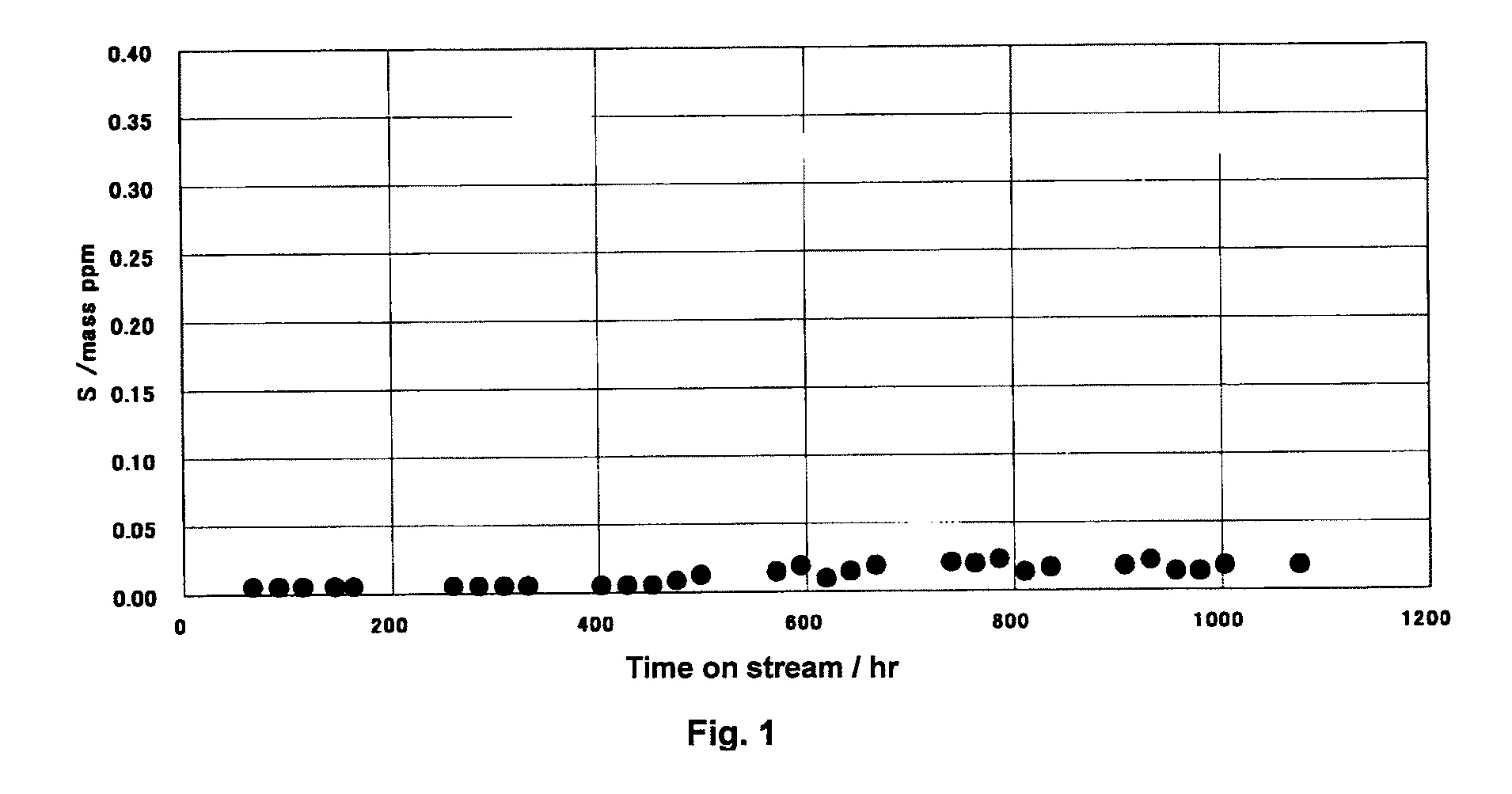Solid acid, method for preparing the solid acid, and method for desulfurizing hydrocarbon oil using the soild acid as desulfurizing agent
a technology of desulfurizing agent and solid acid, which is applied in the direction of electrochemical generator, coating, other chemical processes, etc., can solve the problems of insufficient solution of above problems, system complexity, and decrease of agent activity, so as to achieve efficient and economical desulfurization, reduce sulfur compounds, and compact facilities
- Summary
- Abstract
- Description
- Claims
- Application Information
AI Technical Summary
Benefits of technology
Problems solved by technology
Method used
Image
Examples
examples
[0085]Hereinafter, the present invention is described in more detail by way of examples. However, the present invention is not limited to the examples.
[Preparation of Desulfurization Agent]
[0086]The following four kinds of γ-alumina were used as alumina raw materials (extrudates):
Alumina A (shape: column with quatrefoil cross section, major axis: 1.3 mm, average length: about 5 mm, specific surface area: 241 m2 / g, pore volume: 0.72 ml / g);
Alumina B (shape: column with quatrefoil cross section, major axis: 1.3 mm, average length: about 5 mm, specific surface area: 302 m2 / g, pore volume: 0.72 ml / g);
Alumina C (shape: column with circular cross section, diameter: 1.6 mm, average length: about 5 mm, specific surface area: 205 m2 / g, pore volume: 0.77 ml / g); and
Alumina D (shape: column with a circular cross section, diameter: 0.8 mm, average length: about 5 mm, specific surface area: 223 m2 / g, pore volume: 0.71 ml / g).
[0087]For each alumina, γ-alumina powder was kneaded with a 3.5% nitric ac...
example 21
Desulfurization Experiment in Continuous Flow System
[0101]The desulfurization agent 15, a weight of 35 g, was filled into a column having a length of 600 mm and an internal volume of 54 ml. Kerosene B was flowed through the column at 25° C. at a flow rate of 0.1 ml / min to perform a desulfurization experiment in continuous flow system. The sulfur content in the desulfurized kerosene discharged from the column was analyzed by the combustion oxidation-ultraviolet fluorescence method in the same manner as that in the above-mentioned experiment. As a result, the sulfur content in desulfurized kerosene was equal to or less than the minimum limit of determination (20 ppb by mass) over a period of 40 hours from beginning of discharge of kerosene from the column. The results confirmed that the desulfurization method of the present invention also exhibited an extremely high desulfurization rate in the desulfurization in continuous flow system.
example 22
[0102]In a desulfurizer with an internal volume of 4.1 L, 0.2 L of copper oxide / silver oxide-supported activated carbon (copper content: 8% by mass, silver content: 1% by mass, and particle size: about 3 mm) as an activated carbon desulfurization agent was filled into the uppermost stream side of the desulfurizer, then, 0.6 L of a copper oxide-supported alumina desulfurization agent (specific surface area: 267 m2 / g, pore volume: 0.64 ml / g, sulfur content: 0.5% by mass, copper content: 0.5% by mass, diameter: 0.8 mm, and particle size: 0.1 to 0.6 mm) as a Brφnsted acid desulfurization agent was filled, and 3.3 L of a sulfated alumina desulfurization agent (spectroscopic peak ratio I1,540 / I1,450:0.000, specific surface area: 295 m2 / g, pore volume: 0.67 ml / g, sulfur content: 0.5% by mass, and particle size: 0.1 to 0.6 mm) as a Lewis acid desulfurization agent were filled into the lowermost stream side of the desulfurizer. The filling was performed by using each of the agents formed int...
PUM
| Property | Measurement | Unit |
|---|---|---|
| specific surface area | aaaaa | aaaaa |
| specific surface area | aaaaa | aaaaa |
| temperature | aaaaa | aaaaa |
Abstract
Description
Claims
Application Information
 Login to View More
Login to View More - R&D
- Intellectual Property
- Life Sciences
- Materials
- Tech Scout
- Unparalleled Data Quality
- Higher Quality Content
- 60% Fewer Hallucinations
Browse by: Latest US Patents, China's latest patents, Technical Efficacy Thesaurus, Application Domain, Technology Topic, Popular Technical Reports.
© 2025 PatSnap. All rights reserved.Legal|Privacy policy|Modern Slavery Act Transparency Statement|Sitemap|About US| Contact US: help@patsnap.com

